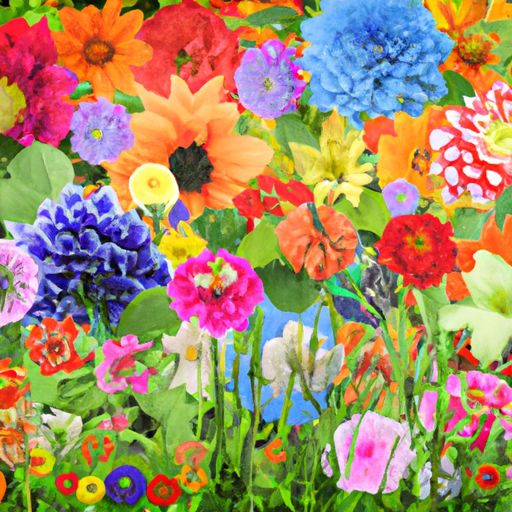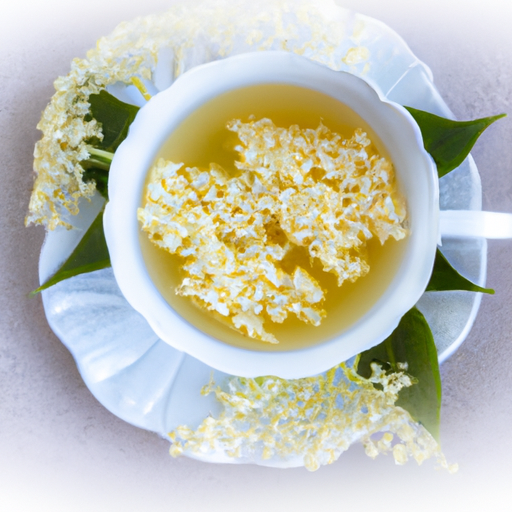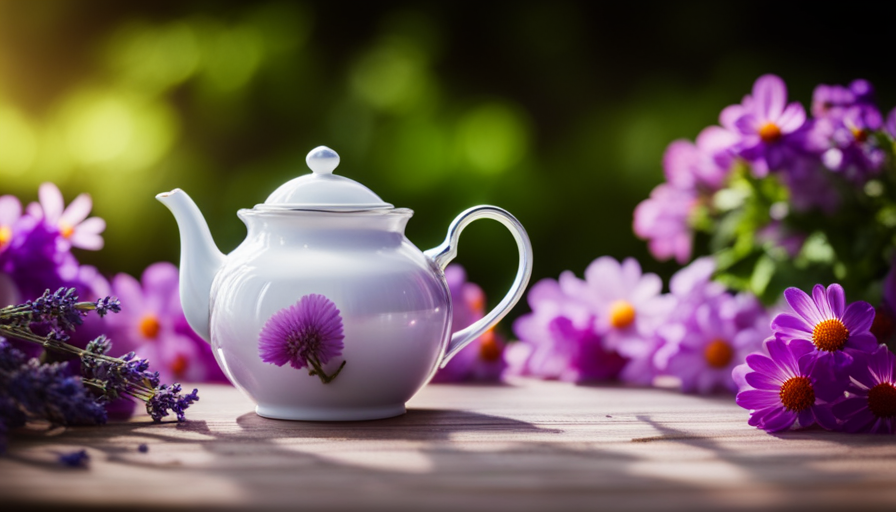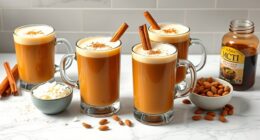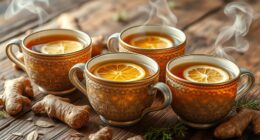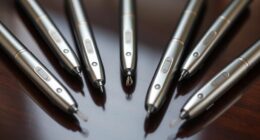Brewing dried flower tea leaves is like conducting a delicate symphony of flavors and aromas, where each sip is a harmonious blend of nature’s gifts.
As a tea enthusiast, I have discovered the exquisite art of infusing dried flowers to create a soothing and rejuvenating beverage. It is a ritual that transcends the ordinary, transforming a simple cup of tea into a sensory experience.
In this article, I will guide you through the enchanting process of brewing dried flower tea leaves. With a few simple steps, you can unlock a world of fragrant petals and vibrant hues, elevating your tea-drinking journey to new heights.
From selecting the perfect dried flowers to experimenting with unique combinations, you will learn how to create your own signature blend.
So, join me on this aromatic adventure and discover the secrets of brewing dried flower tea leaves. Get ready to indulge in the delicate dance of flavors and immerse yourself in the countless health benefits that await.
Let’s embark on this journey together and brew a cup of floral bliss!
Key Takeaways
- Brewing dried flower tea is a sensory experience that combines flavors and aromas.
- Different dried flowers bring unique flavors and benefits to the tea.
- Mixing different dried flowers together can create custom blends of tea.
- Brewing dried flower tea offers various health benefits, such as relaxation and antioxidants.
Choose Your Dried Flowers
Now it’s time for you to choose your dried flowers and create a tea blend that suits your taste buds. When it comes to dried flower tea, there are a variety of options to choose from. Lavender, chamomile, rose petals, and hibiscus are just a few examples of the different types of dried flowers you can use.
Each flower brings its own unique flavor and benefits to the tea. Lavender is known for its calming properties, while chamomile has a soothing effect on the body and mind. Rose petals add a delicate floral note, and hibiscus gives the tea a tart and refreshing taste. Consider mixing different flowers together to create your own custom blend and experiment with the flavors.
In addition to their taste, dried flower teas offer various health benefits. Lavender can help with relaxation and sleep, chamomile aids digestion, rose petals are rich in antioxidants, and hibiscus is known to lower blood pressure.
Now that you have an idea of the different types of dried flowers to use and the benefits of drinking dried flower tea, let’s move on to the next step: gathering your supplies.
Gather Your Supplies
To brew dried flower tea leaves, you’ll need a few essential supplies.
First, you’ll need a tea infuser or strainer. This will keep the tea leaves contained while allowing the flavors to infuse into the water.
Second, boiling water is essential. It will properly steep the tea leaves and release their flavors.
Finally, you’ll need a teapot or mug. This will hold the brewed tea and make it easier to pour and enjoy.
Tea infuser or strainer
For the ultimate tea experience, get ready to unleash the botanical powers of your dried flower tea leaves with a trusty tea infuser or strainer – your secret weapons to extract every ounce of flavor and aroma in a snap! Tea brewing techniques are elevated with the use of a tea infuser or strainer. These handy tools allow for the easy steeping of loose tea leaves, ensuring a perfectly brewed cup every time. The benefits of using a tea infuser include the ability to control the strength of your tea by adjusting the amount of leaves, as well as the convenience of easy cleanup. With a tea infuser or strainer, you can savor the delicate flavors and aromas of your dried flower tea leaves, creating a truly satisfying tea experience. Now, let’s move on to the next step: boiling water.
Boiling water
Get ready to experience the transformation as you watch the water in your kettle bubble and steam, ready to release its heat and energy into your cup.
Boiling water is an essential step in brewing dried flower tea leaves, as it helps to extract the flavors and nutrients from the flowers. However, it’s important to choose the right temperature for boiling water to ensure a perfect brew. Different types of tea require different temperatures, so it’s crucial to refer to the specific instructions for your dried flower tea leaves.
Boiling water also offers health benefits, as it helps to kill any bacteria or impurities that may be present in the water.
Once the water has reached the ideal temperature, you can pour it over your dried flower tea leaves and let it steep. This will allow the water to infuse with the flavors and aromas of the flowers, creating a delightful tea experience.
Now, let’s move on to the next step and explore the options of using a teapot or mug.
Teapot or mug
Imagine the satisfaction of pouring the perfectly boiled water into your chosen vessel, whether it’s a teapot or a cozy mug, ready to embark on a journey of flavors and sensory delight.
When it comes to brewing dried flower tea leaves, the choice between a teapot and a mug is a matter of personal preference. Both options have their benefits, but using a teapot allows for a more traditional and elegant experience, while a mug offers convenience and simplicity.
Whichever vessel you choose, using a tea infuser is highly recommended. It ensures that the dried flowers are properly steeped, allowing their flavors and aromas to infuse the water thoroughly. As the tea infuses, it gradually transforms into a fragrant and visually pleasing beverage.
So, once you have your teapot or mug ready, let’s move on to the next step: properly storing your dried flowers.
Properly Store Your Dried Flowers
To ensure the freshest flavor and aroma in your dried flower tea, you’ll want to store them properly. Proper storage techniques and the right containers are key to preserving the quality of your dried flowers.
The first step is to choose the best containers for storage. I recommend using airtight glass jars or metal tins with tight-fitting lids. These containers will help protect the dried flowers from moisture, light, and air exposure, which can degrade their flavor and aroma over time.
It’s important to store the dried flowers in a cool, dark place, such as a pantry or cupboard, away from direct sunlight and heat sources. This will help maintain their freshness and prevent them from losing their potency.
Additionally, make sure to label the containers with the name of the dried flowers and the date of purchase or harvest. This will help you keep track of their freshness and ensure you use them within the recommended timeframe.
Now that you know how to properly store your dried flowers, let’s move on to the next step: measuring the amount of dried flowers for brewing your tea.
Measure the Amount of Dried Flowers
Make sure you’ve got the perfect balance of flavor by accurately measuring the amount of your dried flowers. Measuring techniques are crucial when it comes to brewing dried flower tea leaves. The accuracy in measuring will determine the strength and taste of your tea.
To ensure a delightful experience, follow these tips:
- Use a digital kitchen scale: This precise tool allows you to measure your dried flowers down to the gram, ensuring consistency in every cup.
- Use a measuring spoon: If you don’t have a scale, a measuring spoon can be a reliable alternative. One tablespoon of dried flowers per 8 ounces of water is a good starting point.
- Eyeballing method: For a more relaxed approach, you can estimate the amount of dried flowers by eyeballing it. However, keep in mind that this method may lead to variations in taste from cup to cup.
Accurate measurement is key to achieving that perfect cup of tea, so take the time to measure your dried flowers properly. Once you have the desired amount, it’s time to move on to boiling water to the appropriate temperature for steeping the tea.
Boil Water to the Appropriate Temperature
In order to make the perfect cup of dried flower tea, it is crucial to boil water to the appropriate temperature. This step is often overlooked, but it can greatly affect the taste and quality of your tea. Boiling water is a simple yet essential process that helps extract the flavors and benefits from the dried flowers.
To ensure that your water is at the right temperature, it is helpful to use a thermometer. Different types of dried flowers require different water temperatures for optimal brewing. For example, delicate flowers like chamomile and lavender should be brewed with water that is around 175°F (79°C), while robust flowers like hibiscus and rosehips can be brewed with water that is at a higher temperature, around 200°F (93°C).
Boiling water has several benefits when it comes to brewing dried flower tea. Firstly, it helps to release the aroma and flavors of the flowers, creating a more enjoyable sensory experience. Additionally, boiling water helps to kill any potentially harmful bacteria or microorganisms that may be present in the dried flowers.
Now that we have the water at the appropriate temperature, let’s move on to the next step: steeping the dried flowers.
Steep the Dried Flowers
Steeping the dried flowers allows their flavors to infuse into the hot water, creating a soothing and aromatic beverage that’ll leave you feeling relaxed and rejuvenated.
When it comes to steeping dried flower tea leaves, there are different techniques you can try to enhance the taste and aroma. One method is to simply add the dried flowers to a teapot and pour hot water over them. Allow the flowers to steep for about 5-7 minutes, depending on your desired strength.
Another technique is to use a tea infuser or a tea bag to hold the dried flowers while they steep. This helps to keep the tea leaves contained and makes it easier to strain later on.
Drinking flower tea has numerous benefits. It’s not only a delicious and refreshing beverage but also offers a range of health benefits. Different flowers have different properties, such as calming effects, antioxidant properties, and immune-boosting qualities. Some flowers, like chamomile, are known for their calming effects, making them the perfect choice for a bedtime tea. Other flowers, like hibiscus, are rich in antioxidants, which can help protect against chronic diseases.
Now that the dried flowers have steeped and released their flavors, it’s time to move on to the next step: straining and serving the tea.
Strain and Serve
Now it’s time for you to experience the delightful aroma and taste of the infused flowers as you strain and pour yourself a soothing cup of this comforting elixir. Straining the brewed flowers is an essential step in achieving a smooth and enjoyable tea. To do this, place a fine-mesh strainer over your teacup or teapot and carefully pour the tea through, allowing the liquid to flow freely while catching any loose petals or debris. The result is a clear, fragrant brew that is visually pleasing and ready to be savored.
As you pour the tea into your cup, take a moment to appreciate the vibrant colors and delicate shapes of the flowers. They add a touch of elegance to your brewing experience. Imagine a table set with a variety of dried flower tea leaves, each with its own unique scent and flavor profile. The tablecloth is adorned with a beautiful arrangement of blooming flowers, creating a serene and inviting atmosphere.
Brewing techniques for dried flower tea leaves may vary depending on the specific flowers used. However, regardless of the technique, the health benefits of these teas remain consistent. They are known for their calming properties, aiding in relaxation and stress relief. Additionally, they can promote digestion and provide antioxidants that support overall well-being.
Now that you have learned how to strain and serve your brewed flowers, you can further enhance your tea experience by adding sweeteners or enhancements (optional).
Add Sweeteners or Enhancements (Optional)
To truly elevate your tea experience, you can customize your brew by adding a touch of sweetness or other enhancements, if desired.
Picture yourself delicately drizzling a spoonful of honey into your cup, watching as it slowly dissolves and infuses the tea with its golden goodness, just like a ray of sunshine brightening up your day. Sweeteners like honey, agave nectar, or maple syrup can enhance the natural flavors of the dried flower tea leaves, adding a delightful sweetness that complements the earthy notes.
If you prefer a more herbal twist, consider adding a splash of fresh lemon juice or a sprinkle of cinnamon. These unique flavor combinations can take your tea to a whole new level, tantalizing your taste buds with their refreshing and aromatic profiles.
As you experiment with different flower combinations, you’ll discover that certain sweeteners or enhancements work better with specific types of tea. For example, lavender tea pairs beautifully with a drizzle of honey, while chamomile tea benefits from a hint of vanilla extract. The key is to find the perfect balance that enhances the natural flavors of the dried flower tea leaves without overpowering them.
So go ahead, get creative, and let your taste buds be your guide as you embark on this flavorful journey.
Now, it’s time to move on to the next step and explore the world of experimenting with different flower combinations.
Experiment with Different Flower Combinations
Discover the endless possibilities of combining different floral elements to create a truly unique and personalized tea experience. When it comes to brewing dried flower tea leaves, experimenting with different flower combinations can elevate your tea-drinking experience to new heights. Not only does it add a delightful visual appeal, but it also allows you to explore a wide range of flavors and aromas.
Here are three ways you can experiment with different flower combinations:
-
Mix and match: Try combining different flowers, such as chamomile, lavender, and rose petals, to create a soothing and calming blend. This combination not only offers a delicate floral taste but also promotes relaxation and a sense of well-being.
-
Balance flavors: Play around with the intensity of flavors by combining stronger flowers like hibiscus with milder ones like jasmine. This combination adds a refreshing twist to your tea while offering a hint of sweetness and a floral aroma.
-
Explore cultural blends: Dive into the rich tapestry of cultural traditions by combining flowers from different regions. For example, pairing chrysanthemum and osmanthus flowers creates a traditional Chinese blend known for its cooling properties and floral fragrance.
By experimenting with different flower combinations, you can discover unique flavors, aromas, and health benefits that suit your personal preferences. Enjoy and reap the health benefits of flower tea by incorporating these diverse brewing techniques into your tea routine.
Enjoy and Reap the Health Benefits
Indulge in the exquisite bouquet of flavors and let the healing powers of these floral elixirs nourish your mind, body, and soul. When it comes to dried flower tea leaves, not only do they offer a delightful taste experience, but they also provide numerous health benefits. Brewing techniques play a crucial role in reaping these benefits.
To start, ensure you use high-quality dried flower tea leaves. Gently place a teaspoon of the leaves in a teapot or infuser and pour hot water over them. Allow the tea to steep for about 5-10 minutes to extract all the goodness from the flowers. Remember, timing is key. Too short a steeping time may result in a weak tea, while too long may make it bitter.
Different flowers offer different health benefits, so choose your combinations wisely. For example, chamomile promotes relaxation and aids in digestion, while lavender helps with stress relief and sleep. Experiment with various flower combinations to find the perfect blend for your desired outcome.
Savor each sip of your floral tea and let its healing properties work their magic. From boosting your immune system to improving digestion, these floral elixirs have a lot to offer. So, take a moment to unwind, enjoy the flavors, and reap the health benefits of your brewed dried flower tea leaves.
Frequently Asked Questions
Are there any flowers that are not suitable for making dried flower tea?
Some flower types, such as roses or daisies, are better suited for decorative purposes rather than brewing tea. While they may look beautiful, their flavors can be lacking or even unpleasant when steeped in hot water. Additionally, it’s important to use organic dried flowers when brewing tea to avoid any potential harmful chemicals or pesticides that may be present in non-organic flowers.
How do I know if my dried flowers are still fresh and suitable for brewing tea?
To determine the freshness of dried flowers for tea, I rely on my senses. Just like picking fresh flowers, I inspect the dried ones for vibrant colors and a strong, aromatic scent. If they appear dull or have a musty smell, it’s likely they have lost their freshness.
To store dried flowers for tea, I keep them in an airtight container away from light and moisture. This helps preserve their flavor and potency for a delightful tea experience.
Can I mix different types of dried flowers together to create unique tea blends?
Mixing different types of dried flowers for tea can offer a range of benefits. Combining flowers like chamomile, lavender, and rose petals can create a soothing blend that promotes relaxation and sleep. Adding dried hibiscus flowers can infuse the tea with a tart flavor and boost its antioxidant properties.
To create unique tea blends with dried flowers, experiment with different combinations and ratios. Consider the flavor profiles and potential health benefits of each flower to create your perfect cup of tea.
Is it necessary to use a specific type of water when boiling for dried flower tea?
Different types of water can indeed affect the taste of dried flower tea. Using filtered water is beneficial for brewing this delicate tea. Just like a clear, calm lake enhances the beauty of a blooming flower, filtered water ensures that the true essence of the dried flowers is extracted, resulting in a pure and vibrant tea.
It removes impurities and chlorine, allowing the natural flavors and aromas to shine through, creating a more enjoyable tea-drinking experience.
Can I reuse the dried flowers to make multiple cups of tea, or should I discard them after one use?
You can definitely reuse dried flowers to make multiple cups of tea. However, it’s important to note that the flavor and aroma may diminish with each use. By reusing the dried flowers, you can still enjoy the mild and subtle taste of the tea.
On the other hand, discarding the flowers after one use ensures that you get the maximum flavor and benefits from the fresh batch of flowers for each cup of tea.
Conclusion
In conclusion, brewing dried flower tea leaves is a delightful and beneficial experience. By following the steps outlined in this article, you can create a soothing cup of tea that not only tastes amazing but also provides numerous health benefits.
Did you know that drinking flower tea can help improve digestion? Studies have shown that certain flowers, such as chamomile and lavender, contain compounds that aid in digestion and reduce bloating. So why not indulge in a cup of flower tea and give your digestive system a boost?
Cheers to your health and happy brewing!




